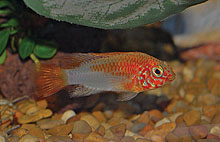WHAT'S NEW ACROSS THE WORLD
Select date in side bar to go to a What's New of previous issues
| What's New
©by Laif DeMason
Just after the release of our last April CN issue, Europe, America, and the rest of the world had to abruptly start dealing with what China and the Far East was wrestling with: The Coronavirus Pandemic! Immediately when announced in mid March a national lockdown was started. With little advance warning, the inbound flights from the rest of the world were halted. No flights meant no fish imports, even though some consignments were already booked and paid in advance. As a tropical fish wholesaler, I knew the effects would have implications on fish varieties and stocks. Although the domestic air service continued as normal for a couple of weeks getting shipments to stores nationally, it took some retailers about a month to realize the stock list would only shrink from here onwards. Many stores relied on locally bred items and came to realize that supply was limited. By the time they concluded that most African cichlids were grown in Florida, the domestic flight situation was severely limited by the non-traveling public and the huge number of flight cancellations. The lockdown is starting to lift now, however, it remains to be seen if the airline industry (both imports and domestic) will change and start flying shipments of tropical fish over the next few months.
Here’s “what’s new” on the cichlid scene: |
Lake Tanganyika
Tanganyika cichlids were the first group of fish impacted by the lockdown as most sold in the USA are imported, whether wild or bred.
| WHAT'S NEW: LAKE TANGANYIKA |

While wild Tropheus sales had already waned, thin March import inventories were all sold off by month’s end. Pictured here, a Tropheus moorii Murago from Lusinga, Congo.
|

In theory, restricted from collection and export from Tanzania, Petrochromis sp. ‘red’ is still bred in small numbers both in America and in Europe.
|

Early this year, African collectors caught hundreds of the rarely seen Cyprichromis sp. ‘leptosoma jumbo’ from Kitumba, Congo. But exporters couldn’t sell all at their exorbitant price to China so by halving the price the rest were sold quickly. Photo by P. Tawil.
|

Also caught in good numbers was the so-called “Speckleback” Cyprichromis from Tembwe Congo. These were initially offered at a high price, but soon some exporters came to see they couldn’t sell all and readjusted their offer.
|
Lake Malawi
The Florida farm-raised stocks of Malawi cichlids have always been strong. The stagnant wild caught Malawi inventory has also picked up with the import bottleneck. Getting the fish to market on the airlines is now the problem, especially Delta Airlines who recently decide not to take live fish on any transfer flights via Atlanta, removing 90% of the national market. Who is going to let Delta know they made a big mistake?

A lot more predatory haplochromines are starting to be bred in Florida. Pictured here Tyrannochromis nigriventer sporting many orange-red markings and body flecks on each scale.
|

The white-lipped variety Placidochronmis phenochilus from Mdoka, Malawi, is finally being bred in Florida after a long time of demand. However, the large pond-bred fish don’t seem to be as nice as the wild caught individuals.
|

Another Malawi item from a much longer time ago is making a comeback via farm-bred fish. The ‘back-then’ called “Giant Flame Oxyrhynchus” is of course not a Hemichromis oxyrhynchus, but Mylochromis lateristriga who were often seen following the former fish foraging in Lake Malawi. Photo by A. Konings.
|

Lastly, due to demand by China, Malawi exporters have sent out recently a not-so-often seen fish, Stigmatochromis pholidophorus. This fish is found lakewide but never seen in numbers. So if you want to breed them, buy what you can, when you can!
|

A newly-developed and colorful Apistogramma morph is becoming widely popular and is sold usually as A. macmasteri gold red mask.
|

Discus varieties continue to evolve and are almost a designer fish from some breeders. Pictured here a striking Marlboro Red type of discus.
|
Select date in side bar to go a What's New of previous issues |









